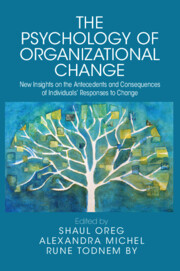 The Psychology of Organizational Change
The Psychology of Organizational Change Book contents
- The Psychology of Organizational Change
- The Psychology of Organizational Change
- Copyright page
- Contents
- Contributors
- Part I Introduction
- Part II The Evolution of Change and Its Responses
- Part III Change in Context
- Chapter 5 Exploring Types of Organizational Change and Differential Effects on Employee Well-Being and Personal Development
- Chapter 6 Employee Responses to Technological Change
- Chapter 7 Identification Change in Chinese Acquisitions in Europe
- Chapter 8 Social Identity Processes in Sino-Western Mergers and Acquisitions
- Part IV The Development of Change Leadership
- Part V The Process of Change Leadership
- Part VI Conclusions and Commentary
- Index
- References
Chapter 7 - Identification Change in Chinese Acquisitions in Europe
The Social Identity Approach
from Part III - Change in Context
Published online by Cambridge University Press: 28 September 2023
- The Psychology of Organizational Change
- The Psychology of Organizational Change
- Copyright page
- Contents
- Contributors
- Part I Introduction
- Part II The Evolution of Change and Its Responses
- Part III Change in Context
- Chapter 5 Exploring Types of Organizational Change and Differential Effects on Employee Well-Being and Personal Development
- Chapter 6 Employee Responses to Technological Change
- Chapter 7 Identification Change in Chinese Acquisitions in Europe
- Chapter 8 Social Identity Processes in Sino-Western Mergers and Acquisitions
- Part IV The Development of Change Leadership
- Part V The Process of Change Leadership
- Part VI Conclusions and Commentary
- Index
- References
Summary
Organizational identification might become weaker when confronted with organizational changes, such as mergers and acquisitions (M&As). Identification change in M&As has received significant attention from scholars, but the extant theoretical evidence might not apply to employees involved in Chinese M&As. Indeed, cultural characteristics (e.g., dialectical thinking, collectivism, power distance) might make Chinese employees more tolerant of contradictions and ambivalence than employees in the Western hemisphere. To address this gap, we will refer to the social identity theory and the extant knowledge on identification change in cross-border M&As. We will present a framework of organizational identification change for Chinese employees after acquisition together with factors that contribute to the success of M&As. We illustrate it with the case of a Chinese acquisition in Europe: ChinaCorp and EuroMall. We theorize on the role of identity leadership wherein a leader’s behavior has a particularly strong impact on identification processes in high power distance and collectivist cultures. We will show how acts of identity leadership matter for the transfer from pre-merger to post-merger identification in the case of Chinese acquirers.
Keywords
- Type
- Chapter
- Information
- The Psychology of Organizational ChangeNew Insights on the Antecedents and Consequences of Individuals' Responses to Change, pp. 148 - 169Publisher: Cambridge University PressPrint publication year: 2023


